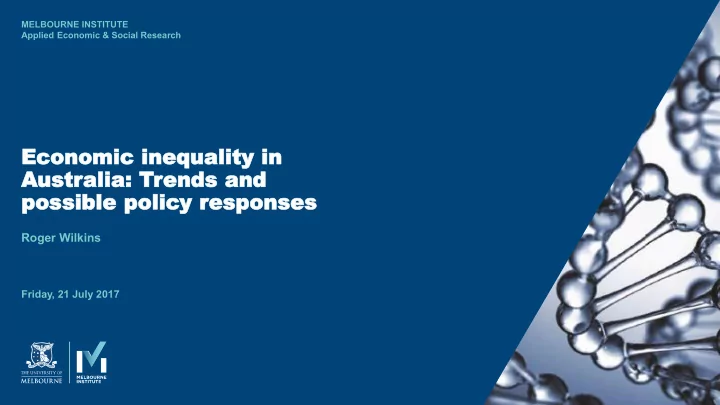

MELBOURNE INSTITUTE Applied Economic & Social Research Eco Econo nomic mic ineq inequa uali lity ty in in Aus ustr tralia: alia: Tren ends ds an and d po poss ssible ible po poli licy y res espo pons nses es Roger Wilkins Friday, 21 July 2017 Page 1
“Australian statistics show that we are at the most unequal we’ve been in 75 years.” Leader of the Opposition, Bill Shorten, speaking on ABC TV’s Q&A program, September 21, 2015. Page 2 Page 2
Top incomes in Australia – Tax records data Income share of the top 1% Persons aged 15 and over 9 8.2% in 2014-15 8 7 % 6 5 4 3 1970-71 1973-74 1976-77 1979-80 1982-83 1985-86 1988-89 1991-92 1994-95 1997-98 2000-01 2003-04 2006-07 2009-10 2012-13
Overall inequality as measured by household surveys Gini coefficient - Equivalised income 0,33 0,32 0,31 0,30 0,29 ABS HILDA 0,28 0,27 2000-01 2002-03 2004-05 2006-07 2008-09 2010-11 2012-13 2014-15
Relative income poverty Proportion in relative poverty (less than half of median income) 14 13 12 % 11 10 9 ABS HILDA 8 2000-01 2002-03 2004-05 2006-07 2008-09 2010-11 2012-13 2014-15
What about the distribution of wealth? Wealth inequality (Gini coefficient) 0,64 0,64 0,63 0,63 0,62 0,62 0,61 ABS HILDA 0,61 0,60 2002-03 2004-05 2006-07 2008-09 2010-11 2012-13 2014-15
Household annual disposable income per capita March 2017 prices - Quarterly seasonally adjusted series 54.000 52.000 50.000 48.000 $ 46.000 44.000 42.000 40.000 38.000 2000 2002 2004 2006 2008 2010 2012 2014 2016
Earnings inequality Gini coefficient - Weekly earnings of full-time employees 0,32 0,30 0,28 0,26 0,24 0,22 0,20 2001 2003 2005 2007 2009 2011 2013 2015 Males Males Females Females
Policies to address economic inequality – a few principles • There are many tools available (and required) • Evaluate the distributional effects of all policies and institutions. • Address inequality of opportunity and inequality of outcomes (It is not enough to tackle inequality of opportunities) • Prioritise tackling the economically inefficient sources of inequality • In-kind income is an important consideration • Don’t underestimate the importance of incentives or the benefits of a market-based economy Page 9
Some policies to address economic inequality Improve progressivity of the income tax and transfer system • Traditional mechanism, and has an important role to play • Reduce various tax expenditures/exemptions (e.g., capital gains) Reduce economic rents • Especially those deriving from government actions – licensing, zoning, regulatory activity, etc. • Competition policy also a useful tool Invest in public education and health systems • Especially helpful for reducing inequality of opportunity Broad-based land tax • Easier and more efficient than a wealth tax Treat gifts and inheritances as taxable income of the recipient Page 10
What I wouldn’t do Increase minimum wages • Better to take steps to improve labour’s productivity and bargaining power Introduce a Universal Basic Income (unconditional payment to all adults) • A decent UBI would require much higher taxes (e.g., $20,000 UBI = $380 billion) and would blunt the benefits of work • Not very effective at reducing inequality (and may increase it) • Also doesn’t appeal as a response to automation: Doesn’t seem to be a good idea to plan for a world in which many or most do not work Taxing capital intensive production (a ‘robot tax’) is likely to be preferable Page 11 Page 11
MELBOURNE INSTITUTE Applied Economic & Social Research Eco Econo nomic mic ineq inequa uali lity ty in in Aus ustr tralia: alia: Tren ends ds an and d po poss ssible ible po poli licy y res espo pons nses es Roger Wilkins Page 12
Recommend
More recommend